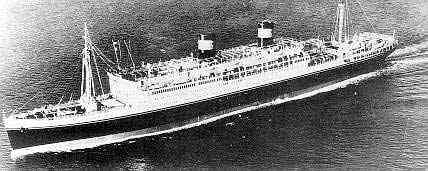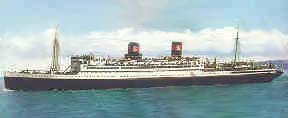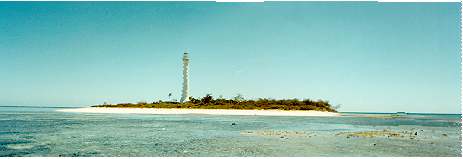 |
Michael McFadyen's Scuba Diving - SS President Coolidge - Crossing the Pacific
 |
| Captain Henry Nelson |
On Monday 28 September 1942, the SS President Coolidge was tied up at Pier 44 in San Francisco Harbor. At 1400 hours at the Armed Guard Center (Pacific) on Treasure Island, San Francisco, California, Lieutenant Chester Craig Hosmer (known as Lt Craig Hosmer), US Navy Reserve, took command of a crew of 45 men, mostly US Navy Reserve, but with some regular sailors. Lt Hosmer, later to be elected a US Congressman, was in charge of the Armed Guard Unit assigned to the ship for its next journey. Armed Guards were responsible for manning the ship's guns as well as providing security for the ship when in port. By 1600 hours all were aboard the Coolidge. The same day, Lt Hosmer started a Log Book entitled "Armed Guard Unit Log Book - S.S.President Coolidge". He was to keep this log right through to 17 November 1942.
Lt Hosmer immediately inspected the ship and found that there were the following guns mounted on the ship (note that he is wrong in his description of decks - I have corrected to as per ships plans):
 |
| The Coolidge on a shakedown cruise |
He also inspected the magazines located forward and aft. Lt Hosmer moved into his cabin, 402 and reported it was satisfactory. Cabin 404 was for his Communications Officer. Three cabins were provided for the gunners. There must have had a few double bunks in each to accommodate 43 men, even taking into account "hot bunking" (where one man leaves his bed to be replaced by another). Later that night all but three of the 45 were granted shore liberty (the ship was guarded by Army).
Over the next few days, Lt Hosmer supervised the loading of stores and supplies for his men. This included one 1903 Springfield .30 rifle serial number 1236496, two Colt .45 pistols serial numbers 794503 and 471366 and two pairs of binoculars. Some items of interest loaded inincluded 2,400 cigarettes, 96 candy bars, 24 tins of tobacco, 6 decks of cards and 2 boxes of matches. In addition, another five Armed Guards boarded the ship. The five were communications seamen under the direction of the Communications Officer, Ensign Doren S. Weinstein, US Navy Reserve. Ensign Weinstein had travelled on the Coolidge's previous journey.
At 0700 hours on Wednesday 30 September 1942, the Coolidge left the wharf under her own power for degaussing ( see separate explanation of this) and compass calibration tests, returning at 1700 hours. At this time, 80 metal boxes containing 540 rounds of boxed metal Mk 1 20 mm high explosive cartridges (lot 1106), 9,000 rounds of the same cartridges from lot 1108 and 4,860 cartridges from lot 1225 were taken on board. Also loaded were 20 rounds of 3" dummy cartridges and 10 30 second dummy time fuses.
 |
| A rare colour photograph of the Coolidge |
The next day the ship again left the wharf and cruised around San Francisco Bay undertaking degaussing and compass calibration.
On Friday 2 October 1942, Lt Hosmer supervised the loading of 1116 rounds of 3" anti-aircraft cartridges, 564 rounds of 3" common cartridges, 196 5" projectiles and 197 5" powder tanks containing powder.
From when the men first boarded the ship till Monday 5 October 1942, Lt Hosmer and his men loaded stores and armaments, undertook maintenance and repairs and carried out drills. At night, regular liberty was granted to enable the men to go ashore. Lt Hosmer also secured another five pairs of binoculars for his men who were, of course, to act as the ship's lookouts.
At 1030 hours on Tuesday 6 October 1942, the SS President Coolidge cast off from Pier 44 and at 1100 hours passed under the Golden Gate Bridge. The ship left San Francisco, bound for New Caledonia (White Poppy in Naval Code) without escort.
This was the ship's very last voyage. The skipper was Captain Henry Nelson, a long serving Dollar and American President lines skipper. He was 63 years old at the time. While Captain Nelson was in charge of the ship, the passengers (troops) were under the command of Colonel Dinsmore Alter, US Coast Artillery. The ship was carrying 4,800 troops as follows:
The 172nd Combat Team of the 43rd Infantry Division was bound for the Solomon Islands. The Coolidge was also carrying a full cargo of supplies, including trucks, jeeps, artillery guns, ammunition and 519lbs of quinine (an anti-malarial drug - the entire reserve supply for the Pacific). Due to the huge number of troops being carried, there were many changes to normal shiplife. For example, meals were served in three shifts, at least for the first few days. One junior officer reported that he was in a cabin made for two people with five other junior officers.
On the first day, Lt Hosmer made arrangements with Lt Dudley, Commanding Officer of the 20th US Navy Construction Battalion (CB), Section 2, for his men to assist the Armed Guards in manning the ship's guns. The arrangement was for 71 men to be on duty at all times, made up of 15 Armed Guards and 56 CBs (also called SeaBees). Training of the CBs began immediately.
Over the coming weeks, the Armed Guards and CBs carried out more drills, including test firing of all guns. As well, there were a number of fire and abandon ship drills for all crew and passengers. Most of the Armed Guard (and presumably rest of passengers) are affected by sunburn.
On Thursday 8 October 1942 the Army conducted test firings of four 37 mm cannons (perhaps one of these is the gun lying above the swimming pool now). These were fired from the decks. The ones on the port and starboard side of the forecastle malfunctioned (I am not sure how as I cannot decipher Lt Hosmer's description of this incident). An inquiry was later held into this incident.
At 0257 hours on Monday 12 October 1942, the SS President Coolidge crossed the Equator at about 149°W. At 1300 hours on the same day, a "King Neptune" ceremony was held. At this ceremony, the "...introduction of Polliwogs into the secrets of Royal Order of Shellbacker".
At 0837 hours on Tuesday 13 October 1942, a periscope was reported by a lookout. This was the second report (the first was the first day out of San Francisco). This time it turned out to be the wake of the ship when turning (it was on a constant zig-zag course) whereas the first time it was a box. At 1228 hours on Thursday 15 October 1942 the ship went off alert after three objects, presumed to be aircraft, were lost from sight.
At 1201 hours on Friday 16 October 1942, there was a breakdown in the engine room and the speed of the ship was reduced. At 1505 hours another three aircraft were sighted. They were identified as US. The next day was lost as the Coolidge crossed the International Date Line. During Sunday 18 October 1942, the engine was repaired and normal speed resumed.
I have been contacted by Craig Schneider whose father, Richard Brown Schneider (now 85 years old - 1998), was in the US Army, 43rd Infantry Division, 172nd Infantry Regiment, Company H, heavy weapons. He served from 1942 to 1945 and was on the President Coolidge on her last voyage. At the time of the sinking he was then about 29 years old. The following is a word for word account of his memories of the trip:
I remember the Coolidge as being a beautiful ship. We left California and spent 17 days on the ocean [actually 12 and a bit to Noumea, 5 in Noumea and one and a bit to Santo] before the sinking. Most of the time was spent either in the mess hall or playing cards and talking to the other men. Many of the men in the hold were very seasick and there was a terrible stench there. I was lucky enough to have a room with a bunk. When we crossed the international dateline many of the men were dunked in the swimming pool. There were no storms and the ship cruised along on a zigzag course.
Another serviceman who was on the Coolidge on her last voyage was Max Evans Senior. He told me via his son (Max Evans Junior - contact by email) about that trip and the following is a word for word recording as well as my comments in square brackets.
As a then 21 year old, I originally left the US in 1942 onboard a ship called the Mooremack Sea. I had been trained as a radio repair technician and part time aerial gunner on B-17s. This ship was enroute to Guadal Canal [Guadalcanal in the Solomon Islands] when a bent propeller shaft resulted in severe vibrations and a top speed of only 7 knots. We diverted to Figi [Fiji] and that is where I, along with about 500 others [more likely about 250], were transferred to the Coolidge [Note that this cannot be correct as the ship did not go to Fiji. It is probable that Mr Evans was actually boarded at Noumea].
The crew assigned me a bunk which was "forward" on the ship, about two decks down. There were lots of bunk beds and there was a bathroom just forward of that. This bathroom was just aft of the crew quarters right behind the "foxel" ... [I think he means forecastle or fo'scle - Comment: this sounds like the stewards' quarters which were on C Deck above the cargo space of Hold One. The stewards' washroom was immediately in front of the two large rooms and they can be seen as you dive the wreck from this hold as you exit on your right hand side]. I ate in a galley about mid-ship, one deck down [this is the First Class Dining Saloon on C Deck]. I remember there being two or three galleys though [yes, there are the Tourist Class Dining Room on the same deck and the Third Class Dining Saloon right at the stern].
 |
Amadee Island and its lighthouse
The Coolidge anchored off here on 20 October 1942 |
During the morning of Monday 20 October 1942, numerous planes and ships were seen, including a cargo ship, two destroyers and other smaller vessels. At 0722 hours it was determined that a small vessel sighted at 0701 hours was in fact a cargo ship, aground on a coral reef. This is, in fact, the reef outside Noumea, New Caledonia, and the ship can still be seen there. At 0725 hours a pilot was taken aboard and at 0815 hours the ship anchored just inside the reef, near the historic Amadee Lighthouse. At 1120 hours a minefield pilot came aboard and the ship weighed anchor at 1130 hours. At 1405 hours it passed through the submarine net and entered Noumea port, anchoring at 1415 hours. Lt Hosmer expressed surprise at the activity in the harbour. He wrote that there were at least 15 navy auxiliaries and cargo ships, some cruisers and destroyers. There were also patrol boats (PTs) and small craft.
Over the next four days the Armed Guards, as well as most, if not all of the passengers, were given liberty in Noumea. No-one was really enthused about Noumea. Lt Hosmer went ashore and reported that the food was fair, there was a complete lack of organisation (doctors riding trucks as guards, pilots supervising ship loading/unloading, PT men driving barges etc). After two days the garbage had still not been removed from the ship. Lt Hosmer asked "Where is our organisation?". A load of 20 mm ammunition was taken aboard.
Joseph Ritz was part of an ordnance company in the Americal Division stationed on New Caledonia during the war. His son, John Ritz of Hopkinton, Massachusetts, has emailed me with the following memories of his father (still alive in Feburary 2002):
One day at morning assembly [this would have been 20 October 1942] the Captain announced that the company had been requested to modify four 155 mm artillery rifles from wheeled mounts to Panama (stationary) mounts. The 155 rifle had a barrel (I would estimate) about 15 feet long and fired a 6.1 inch diameter shell. We were asked to take the gun barrel off the six wheel mount and put it on a circular plate which would later be welded and bolted to a concrete and steel base so that it could be swung through an arc of 180 degrees. The catch was that the bases were being constructed in Espiritu Santo, New Hebrides and the 155s and their attached mounts would be transported on the U.S.S. President Coolidge [sic]. The Coolidge was in Noumea harbor, due to leave in four days. With one day for loading, we had three days.
Under searchlights at night and under the sun during the day every available man pitched in. I wire-brushed parts and sanded welds and hustled cylinders of acetylene, helped torque bolts - anything that was needed. Everyone pitched in and the job was complete in two and a half days. This resulted in the award of the Meritorious Unit Citation.
On the fourth day we watched and waved as the Coolidge left the harbor. Two weeks later we received the news that the ship Captain entered Espiritu Santo harbor, took a wrong turn, hit a mine and, thinking he could beach the boat, reversed engines, went into the deepest part of the harbor and lost the Coolidge and the shore battery of four 155mm rifles on Panama mounts.
At least three of these guns appear to be visible on the wreck now. See the Coolidge dive page.
On Friday 23 October 1942, the US Navy's Noumea Port Director, Lieutenant Commander John D. Andrews, prepared the sailing instructions for the next section of the Coolidge's journey. At 1530 hours on Saturday 24 October 1942, a pilot came aboard the ship and she weighed anchor. At 1545 hours the ship passed throught the submarine net and at 1739 hours the ship again passed Amadee Island and the pilot left the ship. This indicates to me that the ship sailed via the open sea rather than travelled through the Havannah-Boulari Passage.
There were now 5,050 Army troops, 50 US Navy Guard (perhaps 51) and Signal personnel (carried on all merchant ships) and 340 (perhaps 339) crew giving a total of 5,440 persons.
The SS President Coolidge was on her way to Espirito Santo ("Button"). The final location was to be the small town of Luganville, located on the northern shore of Segond Channel on the island of Espirito Santo, New Hebrides (now Vanuatu).
For the next part of the SS President Coolidge story, click here.
For links to all the information on the ship see the Main SS President Coolidge Index Page.
References:
See References Page.
|  |

 v6.00.307 © 2003-2005
v6.00.307 © 2003-2005